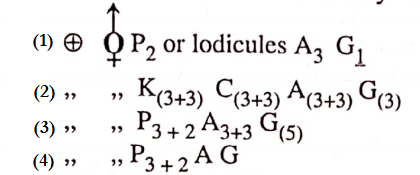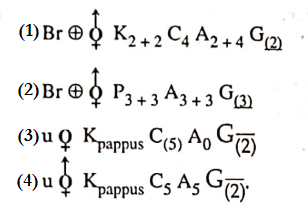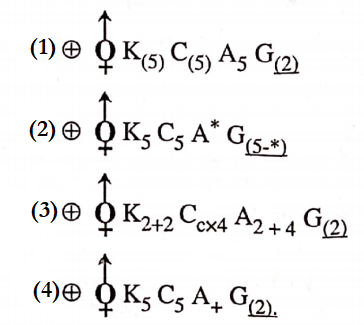NEET Biology Classification Of Taxonomy Of Angiosperms Multiple Choice Questions
Question 1. Which are the major divisions of the plant kingdom according to Bentham and hooker’s natural system of classification?
- Monocotyledons and dicotyledons
- Angiosperms and gymnosperms
- Cryptogammae and phanerogammae
- Unicellular and multicellular plants.
Answer: 1. Monocotyledons and dicotyledons
Question 2. Angiosperms differ from gymnosperms in possessing:
- Xylem vessel
- Ovule
- Xylem tracheids
- Seeds.
Answer: 1. Xylem vessel
Question 3. Loranthus is :
- Parasite
- Epiphyte
- Symbiont
- Saprophyte.
Answer: 1. Parasite
Read and Learn More NEET Biology Multiple Choice Question and Answers
Question 4. In dicots, vascular bundles are:
- Scattered
- Closed
- Concentric
- Arranged in ring.
Answer: 4. Arranged in ring.
Question 5. In monocots, the floral parts occur in groups of:
- Two
- Three
- Four
- Five.
Answer: 2. Three
MCQs on Taxonomy of Angiosperms for NEET Question 6. Which of the following is a marine angiosperm:
- Potamogeton
- Zostera
- Utricularia
- Vallisneria.
Answer: 2. Zostera
Question 7. Which of the following is an insectivorous plant?
- Pinus
- Viscum
- Nepenthes
- Cuscuta.
Answer: 3. Nepenthes
Question 8. Which of the following is a dicot?
- Pulse
- Cereal
- Palm
- None of the above.
Answer: 1. Pulse
Question 9. Which of the following is a monocot?
- Mango
- Citrus
- Pulse
- Cereals.
Answer: 4. Cereals.
Question 10. Select the smallest angiosperm:
- Lotus
- Wolffia
- Rafflesia
- Sugar beet.
Answer: 2. Wolffia
Question 11. A grass becoming tree-like:
- Bamboo
- Veterinarian (khus)
- Eucalyptus
- All of the above.
Answer: 1. Bamboo
Question 12. Which of the following angiosperm spreads over the largest area?
- Ficus bengalensis
- Ficus religiosa
- Ficus elastica
- Sequio gigantea.
Answer: 1. Ficus bengalensis
MCQs on Taxonomy of Angiosperms for NEET Question 13. Which of the following is called sundew?
- Lotus
- Drosera
- Utricularia
- Nepenthes.
Answer: 2. Drosera
Question 14. Monocotyledonous leaf showing reticulate venation is found in:
- Smilax
- Zea mays
- Cocos
- Calophyllum.
Answer: 1. Smilax
Question 15. In which of the following seed germinates when still attached to the main plant?
- Mango
- Rhizophora
- Secrewpire
- Coconut.
Answer: 2. Rhizophora
Question 16. Double fertilization is characteristic of:
- Angiosperm
- Gynmosperm
- Algae
- Pteridophytes.
Answer: 1. Angiosperm
Question 17. Insectivorous plants grow in soil which is deficient in:
- Calcium
- Magnesium
- Nitrogen
- Hormones.
Answer: 3. Nitrogen
Questions On Taxonomy Of Angiosperms
Question 1. Bauhinia, cassia, maraca, and Tamarindus belong to the sub-family:
- Mimosoideae
- Caesalpinoideae
- Cruci free
- Malvaceae.
Answer: 2. Caesalpinoideae
MCQs on Taxonomy of Angiosperms for NEET Question 2. Acacia, albizzia and mimosa belong to:
- Mimosoideae
- Acanthaceae
- Gramineae
- None of the above.
Answer: 1. Mimosoideae
Question 3. The family originally named after a characteristic type of inflorescence found in them, is
- Malvaceae
- Euphorbiaceae
- Asteraceae
- Fabaceae.
Answer: 3. Asteraceae
Question 4. Family Cruciferae is also known as:
- Tetradynamaceae
- Brassicaceae
- Raphanaceae
- Siliquaceae.
Answer: 2. Brassicaceae
Question 5. Cereals are found in the family :
- Compositae
- Solanaceae
- Leguminosae
- Gramineae.
Answer: 1. Compositae
Question 6. Helianthus, sonchus, dahlia and ageraium belong to:
- Compositae
- Lauraceae
- Mimosoideae
- Malvaceae.
Answer: 1. Compositae
Question 7. Lycopersicum, capsicum, datura, and Atropa belong to:
- Liliaceae
- Solanaceae
- Leguminosae
- Malvaceae.
Answer: 2. Solanaceae
Question 8. For the basis of classification, floral characters of higher plants are taken as a basis because:
- Flowers can be easily preserved
- Flowers show great variety in structure and colors
- Reproductive parts are more conservative than other parts
- None of the above.
Answer: 3. Reproductive parts are more conservative than other parts
Mcqs on taxonomy of angiosperms Question 9. The floral diagram represents the following:
- Position of the flower
- Number and arrangement of floral parts in the flower
- Structure of the flower
- Habit of the plant.
Answer: 2. Number and arrangement of floral parts in the flower
Question 10. The botanical name of cauliflower is:
- Brassica oleraceae var. Botrytis
- Brassica oleraceae var. Gongyloides
- Brassica oleraceae var. Capitata
- Brassica oleraceae var. Gemmifera.
Answer: 1. Brassica oleraceae var. Botrytis
Question 11. Which is the most advanced family of dicots?
- Ranunculaceae
- Capparidaceae
- Rosaceae
- Compositae.
Answer: 4. Compositae.
Question 12. The most primitive family of dicots is :
- Ranunculaceae
- Caryophyllaceae
- Cucurbitaceae
- Solanaceae.
Answer: 1. Ranunculaceae
Question 13. Calyx is described in terms of:
- Number of sepals, free or united
- Colour and shape
- Activation and special appendages
- All of the above.
Answer: 4. All of the above.
Mcqs on taxonomy of angiosperms Question 14. Cotton is obtained from the plants belonging to the family:
- Mimosoideae
- Malvaceae
- Palmae
- Rutaceae.
Answer: 2. Malvaceae
Question 15. The pulses-yielding family is :
- Leguminosae
- Cucurbitaceae
- Rosaceae
- Solanaceae.
Answer: 1. Leguminosae
Question 16. The lady’s finger belongs to :
- Cucurbitaceae
- Capparidaceae
- Solanaceae
- Malvaceae.
Answer: 4. Malvaceae.
Question 17. The typical floral formula of the family Gramineae is:
Answer: 1. ![]()
Question 18. To which of the following families does allium cepa belong?
- Liliaceae
- Solanaceae
- Papilionatae
- Cruciferae.
Answer: 1. Liliaceae
Question 19. Ray-florets and disc-florets are the characteristic features of:
- Cruciferae
- Malvaceae
- Compositae
- Solanaceae.
Answer: 3. Compositae
Mcqs on taxonomy of angiosperms Question 20. The stamens of Cruciferae are:
- Monoadelphous
- Tetradynamous
- Didynamous
- Epipetalous.
Answer: 2. Tetradynamous
Question 21. In Malvaceae, the androecium is characteristically
- Monadelphous and free
- Diadelphous and free
- Monadelphous and epipetalous
- Diadelphous and epipetalous.
Answer: 3. Monadelphous and epipetalous
Question 22. In compositae the placentation is:
- Basal
- Marginal
- Free central
- Axile.
Answer: 1. Basal
Question 23. In Liliaceae, flowers are:
- Trimerous and hypogynous
- Pentamerous and epigynous
- Trimerous and epigynous
- Tetramerous and hypogynous.
Answer: 1. Trimerous and hypogynous
Question 24. Epicalyx, axile placentation, and monadelphous condition are found in:
- Cruciferae
- Solanaceae
- Umbelliferae
- Malvaceae.
Answer: 4. Malvaceae.
NEET Biology Plant Kingdom Angiosperm Question 25. Which type of placentation is found in Cruciferae?
- Parietal
- Axile
- Marginal
- Basal.
Answer: 1. Parietal
Question 26. A caryopsis fruit is a characteristic of the family:
- Gramineae
- Cruciferae
- Leguminosae
- Malvaceae.
Answer: 1. Gramineae
Question 27. Siliqua or silicula fruit is a characteristic of the family:
- Gramineae
- Cruciferae
- Rutaceae
- Compositae.
Answer: 2. Cruciferae
Question 28. Leguminosae is a vast family. The basis for its further division into the three families i.e. Papilionatae, caesalpiniodeae, and Mimosoideae are:
- Nature of corolla
- Number of arrangements of stamens
- Type of placentation and fruit
- Both 1 and 2.
Answer: 4. Both 1 and 2.
Question 29. The presence of a false septum (replum) in the ovary is a characteristic of the family :
- Cruciferae
- Malvaceae
- Gramineae
- Compositae.
Answer: 1. Cruciferae
Question 30. The condition of androecium in papilionatae is:
- Monadelphous
- Diadelphous
- Polyadelphous
- Syngenesious.
Answer: 2. Diadelphous
Question 31. In Solanaceae, the placentation is:
- Axile
- Marginal
- Basal
- Superficial.
Answer: 1. Axile
Question 32. Which one of the following correctly represents the condition of the androecium in Papilionaceae?
- Monadelphous and epipetalous
- Diadelphous and epipetalous
- Monadelphous and free
- Diadelphous.
Answer: 4. Diadelphous.
Question 33. The floral diagram provides information about flowers concerning:
- Number of parts of a flower
- The general structure, cohesion, and adhesion
- Position of flower concerning mother axis
- All of the above.
Answer: 4. Position of flower for mother axis
NEET Biology Plant Kingdom Angiosperm Question 34. The inflorescence in compositae is:
- Umbel
- Spike
- Capitulum
- Catkin.
Answer: 3. Capitulum
Question 35. The androecium in compositae is:
- Syngenesious and epipetalous
- Polyandrous and syngenesious
- Epipetalous and monadelphous
- Polyandrous and monoadelphous.
Answer: 1. Syngenesious and epipetalous
Question 36. The type of placentation in Leguminosae is :
- Capitulum
- Superficial
- Marginal
- Axile.
Answer: 3. Marginal
Question 37. The unit of inflorescence in Gramineae is :
- Basal
- Catkin
- Spikelet
- Panicle.
Answer: 3. Spikelet
Question 38. The number of small scaly lodicules which form the perianth in the family Gramineae is:
- Two
- Five
- One
- Four.
Answer: 1. Two
NEET Biology Plant Kingdom Angiosperm Question 39. Wheat belongs to the family:
- Leguminosae
- Gramineae
- Liliaceae
- Solanaceae.
Answer: 2. Gramineae
Question 40. Which of the following is a sign of a zygomorphic flower?
- ⊕
- 5
- 9
- 9
Answer: 2. 5
Question 41. The androecium is indefinite and polyandrous in :
- Mimosoideae
- Papilionatae
- Malvaceae
- Rutaceae.
Answer: 1. Mimosoideae
Question 42. Which of the following is the floral formula of Asphodelus tenuifolius (liliaceae)?

Answer: 2.![]()
Plant Taxonomy for NEET MCQs Question 43. Vexillum, alae, and keel are present in the family:
- Liliaceae
- Solanaceae
- Asteraceae
- Papilionaceae.
Answer: 4. Papilionaceae.
Question 44. In which of the family is gynoecium carpellary syncarpous?
- Labiatae
- Solanaceae
- Cruciferae
- In all three.
Answer: 4. In all the three.
Question 45. Mimosa belongs to the family :
- Mimosoideae
- Rosaceae
- Malvaceae
- Cruciferae.
Answer: 4. Cruciferae.
Question 46. Flowers are epigynous in family:
- Malvaceae
- Rutaceae
- Cruciferae
- Compositae.
Answer: 4. Compositae.
Question 47. In which flower is the odd sepal anterior?
- Lathyrus odoratus
- Ocimum basilicum
- Asphodelus tenuifolius
- Brassica campestris.
Answer: 1. Lathyrus odoratus
Plant Taxonomy for NEET MCQs Question 48. Flowers are trimerous in the family:
- Malvaceae
- Labiatae
- Liliaceae
- Rosaceae.
Answer: 3. Liliaceae
Question 49. Numerous flowers are found in the family :
- Rosaceae
- Cruciferae
- Malvaceae
- Compositae.
Answer: 2. Cruciferae
Question 50. How many genera are present in the family Cruciferae (Brassicaceae)?
- 275
- 375
- 400
- 475.
Answer: 2. 375
Question 51. Which of the following belongs to the family Brassicaceae?
- Cajanus cajan (arhan)
- Dolichos lablab (sem)
- Archis hypogea (groundnut)
- All of the above.
Answer: 4. All of the above.
Question 52. In which of the family is the ovary obliquely placed?
- Solanaceae
- Malvaceae
- Rosaceae
- Cruciferae.
Answer: 1. Solanaceae
Question 53. Gramineae includes plants which are called:
- Cereals
- Herbs
- Pulses
- Shrubs.
Answer: 1. Cereals
Plant Taxonomy for NEET MCQs Question 54. Which of the following is known as the ‘sunflower family’?
- Asteraceae
- Fabaceae
- Poaceae
- None of the above.
Answer: 1. Asteraceae
Question 55. Bisexual flower is a flower in which:
- Only petals are present
- Only stamens are present
- Only gynoecium is present
- Both stamens and pistil are present
Answer: 4. Both stamens and pistil are present
Question 56. Perianth is reduced to lodicules in the family :
- Liliaceae
- Gramineae
- Compositae
- Malvaceae.
Answer: 2. Gramineae
Question 57. Most important cereal crop of india is:
- Nymphaea
- Allium cepa
- Triticum vulgare
- Pisum sativum.
Answer: 3. Triticum vulgare
Question 58. Which of the following belongs to the family astera-ceae?
- Zinnia and Dahlia
- Chrysanthemum and helianthus
- Aster
- All of the above.
Answer: 4. All of the above.
Question 59. Papilionaceous corolla is found in:
- Pisum sativum
- Mimosa pudica
- Delonix regia
- Brassica campestris.
Answer: 1. Pisum sativum
Plant Taxonomy for NEET MCQs Question 60. Mimosoideae is characterized by:
- 10 Stamens in two whorls of 5 each
- 10 Stamens out of which 3 are staminodes
- 10 Free stamens
- Numerous free stamens.
Answer: 4. Numerous free stamens.
Question 61. Tamarindus indica, the common tamarind tree belongs to:
- Cruciferae
- Mimosoideae
- Caesalpinoideae
- Papilionatae.
Answer: 4. Papilionatae.
Question 62. A flower has five fused sepals, five fused petals, 5 epipetalous free stamens and carpellary, syncarpous superior ovary with a swollen axile oblique placenta which family will you assign to the flower?
- Solanaceae
- Leguminosae
- Compositae
- Cruciferae.
Answer: 1. Solanaceae
Question 63. Seeds of which of the following yield edible oil?
- Artemisia
- Sunflower
- Safflower
- All of the above.
Answer: 4. All of the above.
Question 64. The floral formula of the family Compositae is
- K5C5A5g(5)
- K5C5A5g(5)
- K6C5A(9)-1G

Answer: 4. ![]()
MCQs on Taxonomy of Angiosperms for NEET Question 65. Which of the following statements is correct for the capitulum of sunflower?
- Ray florets are outer, disc florets are inner
- Disc florets are outer, ray florets are inner
- Both are in the center of the Capitulum
- Both are located on the periphery.
Answer: 1. Ray florets are outer, disc florets are inner
Question 66. Sonchus belongs to:
- Cruciferae
- Rutaceae
- Malvaceae
- Compositae.
Answer: 4. Compositae.
NEET Biology Questions With Answers
Question 67. The presence of vexillum (standard), wings (alae), and keel (carina) is a characteristic feature of the family:
- Rutaceae
- Cruciferae
- Malvaceae
- Papilionatae.
Answer: 4. Papilionatae.
Question 68. The floral formula:

- Cruciferae
- Malvaceae
- Rosaceae
- Papilionatae.
Answer: 4. Papilionatae.
Question 69. Cassia fistula belongs to the sub-family: acacia belongs to:
- Cruciferae
- Malvaceae
- Rosaceae
- Cruciferae
Answer: 4. Cruciferae
Question 70. What is the diagnostic character of the Cruciferae family?
- Presence of ray and disc florets
- Presence of a staminal tube
- Presence of four clawed and diagonally arranged petal, tetradynamous condition
- None of these.
Answer: 1. Presence of ray and disc florets
Question 71. Which set of the following plants belong to the family Liliacaeae:
- Onion, garlic and asparagus
- Smilax, aloe and gloriosa
- Urginea, scilla, and yucca
- A11 of above.
Answer: 3. Urginea, scilla, and yucca
Question 72. The scientific name of the common tomato is:
- Raphanus sativus
- Lycopersicum esculentum
- Murraya
- Lberis.
Answer: 4. Lberis.
Question 73. Asphodelus tenuifolius belongs to:
- Cruciferae
- Malvaceae
- Liliaceae
- Rutaceae.
Answer: 2. Liliaceae
NEET Important Questions Biology
Question 74. The condition of the androecium in Compositae is:
- Diadelphous
- Didynamous
- Syngenesious
- Monadelphous.
Answer: 3. Syngenesious
Question 75. Cereals are found in the family:
- Cruciferae
- Solanaceae
- Gramineae
- Leguminosae.
Answer: 3. Gramineae
Question 76. Angiosperms originated about how many million years ago:
- 20
- 100
- 130
- 200.
Answer: 3. 130
Question 77. In arachis hypogea corolla is
- Cruciform
- Papilionaceous
- Bilabiate
- Infundibuliform.
Answer: 3. Bilabiate
Question 78. Spirocyclic flowers are present in the family :
- Ranunculaceae
- Cruciferae
- Malvaceae
- Leguminosae.
Answer: 2. Cruciferae
Question 79. The typical floral formula of the family Cruciferae is:

Answer: 3. 
Question 80. Spirocyclic flowers are present in the family :
- Ranunculaceae
- Cruciferae
- Malvaceae
- Leguminosae
Answer: 1. Ranunculaceae
Question 81. The names dicots and monocots are based on the number of cotyledons in the embryo. Which of the following is not true for monocotyledons:
- Parallel venation in leaves
- Scattered vascular bundles
- Tap roots grow profusely
- Flower parts in sets of 3
Answer: 3. Tap roots grow profusely
NEET Important Questions Biology
Question 82. The typical formula for Gramineae is:

Answer: 4. 
Mcqs on taxonomy of angiosperms Question 83. Polyadelphous condition is characteristic of the family:
- Compositae
- Malvaceae
- Liliaceae
- Rutaceae.
Answer: 4. Rutaceae.
Question 84. In which of the following families calyx is modified into pappus?
- Cruciferae
- Leguminosae
- Compositae
- Solanaceae.
Answer: 3. Compositae
Question 85. One of the statements does not apply to the family Cruciferae:
- Flowers are pentamerous
- Flowers are ebracteate
- Fruit is siliqua
- Stigmas are usually commissural.
Answer: 1. Flowers are pentamerous
Question 86. Which of the following represents the condition seen in the family Compositae?
- Superior ovary, axile placentation
- Inferior ovary, axile placentation
- Superior ovary, single basal ovule
- Inferior ovary, single basal ovule.
Answer: 4. Inferior ovary, single basal ovule.
Question 87. Cereals are found in the family :
- Malvaceae
- Cruciferae
- Gramineae
- Leguminoseae.
Answer: 4. Leguminoseae.
NEET Important Questions Biology
Question 88. Petunia differs from the rest of the Solanaceae in having:
- Numerous ovules and stamens with apical pores
- Infundibuliform corolla and persistent calyx
- Irregular calyx and unequal filaments
- Swollen placenta and accrescent calyx.
Answer: 3. Irregular calyx and unequal filaments
Mcqs on taxonomy of angiosperms Question 89. Major food crops of the world belong to:
- Leguminosae
- Solanaceae
- Gramineae
- Cruciferae.
Answer: 3. Gramineae
Question 90. Triticum aestivum is:
- Diploid
- Triploid
- Haploid
- Hexaploid.
Answer: 4. Hexaploid.
Question 91. Asphodelus tenuifolius differs from the rest of the lilaceae in the presence of:
- Cortical roots and centric leaves
- Gamophyllous perianth and distinct stamens
- Gamophyllous perianth and epiphyllous
- Polyphyllous perianth and epiphyllous stamens.
Answer: 3. Gamophyllous perianth and epiphyllous
Question 92. Allium differs from the rest of lilliaceae in:
- Absence of umbel inflorescence and centric leave
- Presence of bulbs and umbel inflorescence
- Absence of umbel inflorescence and bulb
- The presence of centric leaves and perianth
Answer: 2. Presence of bulbs and umbel inflorescence
